Enhancing productivity and quality of cabbage through precision farming practices in Indian cold arids
Bạn đang xem bản rút gọn của tài liệu. Xem và tải ngay bản đầy đủ của tài liệu tại đây (320.03 KB, 10 trang )
Int.J.Curr.Microbiol.App.Sci (2019) 8(9): 1363-1372
International Journal of Current Microbiology and Applied Sciences
ISSN: 2319-7706 Volume 8 Number 09 (2019)
Journal homepage:
Original Research Article
/>
Enhancing Productivity and Quality of Cabbage through Precision
Farming Practices in Indian Cold Arids
M. S. Kanwar1*, M. S. Mir2 and P. Ishfaq Akbar3
1
KVK (SKUAST-K), Nyoma, Ladakh, India
Director Research, SKUAST-K, Srinagar, India
3
Sher-e-Kashmir University of Agricultural Sciences & Technology of Kashmir
High Mountain Arid Agriculture Research Institute, India
2
*Corresponding author
ABSTRACT
Keywords
Cabbage, mulch,
drip, sprinkler, B:C
ratio
Article Info
Accepted:
15 August 2019
Available Online:
10 September 2019
The precision farming including plasticulture applications has proven its
worth in realizing more output per unit of inputs and resources bestowed on
to land. As an alternative to raise production and productivity especially to
compete global trade and meet out own requirements. Cabbage is grown
extensively in summers in Ladakh region and is stored for winters. Due to
lack of scientific know how, improved varieties and modern precision
farming techniques, crop yield and quality is comparatively low. Therefore,
cabbage cultivation tried with precision farming practices including crop
geometry, mulching and micro-irrigation methods to get early and higher
yield with good quality heads at Precision Farming Development Centre,
Leh. Black plastic mulching along with drip irrigation showed considerable
improvement in yield as well good quality heads. Drip irrigation was found
to be best method of irrigation during summer cabbage production.
Mulching also reduced the labour cost in water application and weeding.
Introduction
Vegetable crops are care intensive and require
proper upkeep and management so as to
harvest their really vested potential. Any
lacunae on this part pose heavy toll on
profitability and in turn keeping the interest of
growers intact in the venture. Dwindling land :
man ratio, harvesting more return from a unit
area of land, disguised unemployment,
improper availability of fruits and vegetables,
malnutrition, generating employment and
satiating needs of dominion population are
major concern awaiting for strategic initiation
and integration having bearing on hastening
production and quality. The precision farming
1363
Int.J.Curr.Microbiol.App.Sci (2019) 8(9): 1363-1372
including plasticulture applications has proven
its worth in realizing more output per unit of
inputs and resources bestowed on to land as an
alternative
to
raise
production
and
productivity especially to compete global
trade and meet out own requirements. Seeing
the efficacy, there is need of harnessing and
leveraging the potential of precision farming
on commercial scale. However, the challenges
lying behind warrant proper retrospection.
Cabbage (Brassica oleracea var. botrytis L.) is
third most important crop in India and in
world (in terms of % share in vegetable
production). Cabbage is basically a cool
season crop and grown extensively during
summers in Ladakh region. It has wide
applicability as vegetable, salad, and pickle in
Ladakh. During May-June, cabbage is not
available locally and people have to depend on
supply from other parts of country. Average
productivity in Jammu and Kashmir is 21.35
t/ha which is at par with the average national
productivity. It is third most important crop of
Leh district but its productivity and quality is
comparatively low due to cultivation of
unknown/untested varieties, lack of scientific
know how and modern precision farming
techniques including plastic application in
form of mulch and micro-irrigation. So, there
is need to standardize cabbage cultivation with
precision farming practices including crop
geometry, mulching and micro-irrigation
methods with the objectives of getting early
produce of cabbage with high productivity and
quality.
Materials and Methods
The experiment was conducted during
summer months in open field conditions at
PFDC Farm, Stakna (Leh) of High Mountain
Arid Agriculture Research Institute under
Sher-e-Kashmir University of Agricultural
Sciences & Technology of Kashmir which is
situated at 3319 m amsl with latitude
33058.551’ NS and longitude 77041.995’ EW.
Climate of the area is typically dry temperate
with extreme fluctuations in the temperature.
Soil of the experimental field is sandy to
sandy loam and used first time for crop
cultivation. Effect of mulching (M0: unmulched and M1: mulched with black
polythene) was studied in cabbage var. Pride
of India at two planting distances i.e. S1 (50
x40 cm) and S2 (50 x 30cm) along with three
methods of irrigation i.e. I1 (flooding), I2
(drip irrigation) and I3 (sprinkler irrigation).
Standard package of practices were followed
to raise healthy crop. Design of the experiment
was split-split plot and material was replicated
3 times. Data were recorded on 10 characters
and subjected to statistical analysis as per
Snedcor and Cochran (1967). Comparison was
done among mulch & un-mulched, spacing
and different methods of irrigation along with
their interactions.
Results and Discussion
Analysis of variance (Table 1) indicated that
mulching showed significant effect on days to
marketable maturity and polar diameter of
head only. Crop geometry significantly
influenced days to marketable maturity, gross
& net head weight, equatorial & polar
diameter of head. However, significant
differences were observed among irrigation
methods for all the characters for all the traits
except stalk length and number of non
wrapper leaves. Interaction effects were
significant for days to marketable maturity
only. However, Spacing x Irrigation as well as
Mulch x Spacing x Irrigation interaction were
significant for equatorial diameter of head. For
all the other characters, interaction effects
were non-significant.
Mulching produced longer stalks while S1
generated higher stalk length (Table 2). Drip
irrigation resulted in maximum stalk length.
Un-mulched cabbage produced higher number
1364
Int.J.Curr.Microbiol.App.Sci (2019) 8(9): 1363-1372
of non-wrapper leaves. Inference can be
drawn that early head formation and maturity
in mulched cabbage reduced the number of
non-wrapper leaves.
Mulched cabbage crop took 72.83 days to
marketable maturity (Table 2) which was
statistically earlier than un-mulched one.
Marketable heads were obtained 10 days
earlier through mulching with black-polythene
due to increase in soil temperature favourable
for early growth. S1 produced statistically
early crop than S2. It may be due to the better
chances of crop growth and less competition
for light and nutrients. Drip irrigation took
minimum days to produce cabbage heads and
was at par with sprinkler irrigation. M1 x S1
produced statistically earliest crop in 64 days
irrespective of any irrigation method. M1 x I2
could produce early crop which was at par
with M1 x I3 and M1 x I1. S1 x I2 took
statistically lesser number of days to maturity
over other S x I interactions except S1 x I3.
Best treatment combination in three way
interaction was M1 x S1 x I2 which was at par
with M1 x S1 x I3 and M1 x S1 x I1.
Similar trends were observed for gross and net
head weight. Gross and net head weights
(Table 3) were maximum in mulched cabbage.
S1 produced statistically higher gross and net
head weight than S2. Gross and net head
weights were maximum in drip irrigated crop
and the performance was at par with sprinkler
irrigated crop. I2 and I3 out yielded I1
statistically w.r.t gross and net head weight.
Although all the interaction effects were nonsignificant; M1 x S1, M1 x I2, S1 x I2 and M1
x S1 x I2 were the best performing
combinations. S1 exhibited maximum
equatorial as well as polar diameter of head
and was statistically superior over S2. Drip
irrigation could produce maximum equatorial
and polar diameter but found to be at par with
sprinkler irrigation.
Yield is the ultimate goal of any breeder as
well as producer beside good crop quality.
Black plastic mulch as well as S1 produced
better yield per ha. Díaz-Pérez (2009) reported
that broccoli plant growth and yield responded
more favorably to dark-colored mulches than
to light-colored mulches. Yield per ha was
maximum to the tune of 302.6 qt/ha in drip
irrigated crop and found to be at par with
sprinkler irrigation. All the interactions were
non-significant. However, M1 x S1, M1 x I2,
S1 x I2 and M1 x S1 x I2 were the best
combinations to produce highest yield of
cabbage var. Pride of India. Higher yields
(4.72 per cent) were obtained for drip
irrigation with plastic mulch as compared to
drip irrigation alone by Tiwari et al., (2003) in
agreement with present findings. The highest
benefit–cost ratio of 8.17 was obtained for
furrow irrigation followed by 6.99 for drip.
However, the highest yield of cabbage var.
Golden Acre was obtained in the micro
sprinkler irrigation treatment (40.23 t/ha)
followed by drip irrigation (38.97 t/ha) and
surface irrigation (33.76 t/ha) by Srivastava
and Chauhan (1999). Present study reveals
that drip irrigation has a definite role in
increasing the productivity of cabbage.
Quality in terms of compactness revealed that
100 per cent compact head were obtained in
treatment combinations of M0xS1xI2,
M1xS1xI2 and M1xS1xI3. Economics of
production is very important for adoption of
technology in a particular area. Highest B:C
ratio of 4.00 was obtained in M1xS1xI2
followed by M0xS1xI3 (3.84) and M0xS1xI2
(3.31). These ratios showed that microirrigation technologies along with mulching
are economically feasible for adoption in cold
arid region.
In contrast, highest benefit–cost ratio of 8.17
was obtained for furrow irrigation followed by
6.99 for drip irrigation by Tiwari et al.,
(2003).
1365
Int.J.Curr.Microbiol.App.Sci (2019) 8(9): 1363-1372
Table.1: Analysis of variance for different character under study
Source of variation
df
Stalk
length (cm)
MSS
Gross head
Net head
weight (g)
weight (g)
Mulch
1
0.72
No. of nonwrapper
leaves
6.38
Days to
marketable
maturity
850.69*
109120
Replication
2
0.04
11.39
104.36
214970
86977
900.92
167.78
27888
Ea
2
0.18
0.61
17.69
37678
25297
190.29
3.64
9227.8
Spacing
1
0.58
5.72
1667.4*
820840*
40497*
3272.8*
2460.5*
18196
Mulch x Spacing
1
0.96
6.13
148.03*
38809
7678.1
413.51
2.27
736.49
Eb
4
0.23
0.08
5.69
61804
14406
148.00
273.85
4646.9
Irrigation method
2
0.21
12.00
114.53*
154360*
75502*
876.46*
466.82*
22167*
Mulch x
method
Irrigation
2
0.01
13.09
21.36*
34164
8887.9
118.45
48.53
3000.5
Spacing x Irrigation
method
2
0.22
2.09
31.86*
116380
19049
530.80*
195.30
3352.8
Mulch x Spacing x
Irrigation method
Ec
2
0.39
4.68
82.03*
53203
15237
556.87*
32.24
5116.1
16
0.11
5.85
4.07
32168
15753
114.31
76.02
5270.2
1366
82728
Equatorial
dia of head
(mm)
693.01
Polar dia of
head (mm)
Yield per
ha (Q)
413.04*
25755
Int.J.Curr.Microbiol.App.Sci (2019) 8(9): 1363-1372
Table.2 Effect of mulch, crop, geometry and MI methods on performance of cabbage
Spacing
MI
method
I1
S1
I2
I3
Mean(MS)i.e. MS1
I1
S2
I2
I3
Mean(MS)i.e. MS2
MI1
Mean
(MI)
MI2
MI3
Mean of M
CD0.05 (M)
CD0.05 (S)
CD0.05 (I)
CD0.05(MS)
CD0.05(MI)
CD0.05(SI)
CD0.05(MSI)
Characters
Stalk length (cm)
Number of non-wrapper leaves
Days to marketable
maturity
M0
M1 Mean (SI) M0
M1
Mean (SI)
M0
M1
Mean (SI)
1.233 1.860
1.547
17.67 17.20
17.43
87.33 65.00
76.17
1.417 1.697
1.557
17.80 19.27
18.53
73.00 63.00
68.00
1.100 2.020
1.560
17.00 15.95
16.47
73.00 64.00
68.50
1.250 1.859
17.49 17.47
77.78 64.00
1.554
17.48
70.89
1.367 1.300
1.333
21.67 16.67
19.67
87.33 85.00
86.17
1.367 1.733
1.550
18.00 19.33
18.67
87.33 77.67
82.50
1.233 0.800
1.017
17.67 16.33
17.00
87.33 82.33
84.83
2.322 1.278
19.11 17.44
87.33 81.67
1.300
18.28
84.50
1.300 1.580
19.67 16.93
87.33 75.00
1.440
18.30
81.17
1.392 1.715
17.90 19.30
80.17 70.33
1.553
18.60
75.25
1.167 1.410
17.33 16.14
80.17 73.17
1.288
16.74
76.67
1.286 1.568
18.30 17.46
82.56 72.83
NS
NS
NS
NS
NS
NS
NS
NS
NS
NS
NS
NS
NS
NS
1367
6.03
2.21
1.75
6.34/3.12
6.12/2.47
2.96/2.47
3.49
Gross head weight (g)
M0
690.0
1177
1168
1012
825.0
691.7
810.0
775.6
757.5
934.5
989.2
893.7
M1
1028
1333
1202
1188
741.7
950.0
768.3
820.0
884.8
1142
985.0
1004
NS
230.08
155.22
NS
NS
NS
NS
Mean (SI)
859.0
1255
1185
1100
783.0
820.8
789.2
797.8
821.2
1038
987.1
Int.J.Curr.Microbiol.App.Sci (2019) 8(9): 1363-1372
Table.3 Effect of mulch, crop, geometry and MI methods on performance of cabbage
Spacing
MI method
I1
I2
I3
Mean(SV)i.e. MS1
I1
S2
I2
I3
Mean(SV)i.e. MS2
Mean (MI) MI1
MI2
MI3
Mean of M
CD0.05 (M)
CD0.05 (S)
CD0.05 (I)
CD0.05(MS)
CD0.05(MI)
CD0.05(SI)
CD0.05(MSI)
S1
Characters
Net head weight (g) Equatorial dia of head (mm) Polar dia of head (mm)
M0
M1 Mean
M0
M1
Mean
M0
M1
Mean
(SI)
(SI)
(SI)
341.7 556.3 449.0 92.45
114.3
103.4
95.68 109.0 102.3
615.4 749.7 682.5 132.3
127.0
129.6
117.9 121.5 119.7
591.7 618.0 604.8 114.8
144.8
129.8
116.4 118.4 117.4
516.2 641.3 578.8 113.2
128.7
110.0 116.3 113.2
120.9
325.0 316.7 320.8 103.7
95.63
99.68
90.59 98.28 94.43
316.7 475.0 395.8 96.79
109.4
103.1
96.43 107.4 101.9
358.3 408.3 383.3 102.1
103.6
102.8
91.93 95.06 93.49
333.3 400.0 366.7 100.9
102.9
92.98 100.3 96.62
101.9
333.3 436.5 384.9 98.09
105.0
93.13 103.6 98.39
101.5
466.0 612.3 539.2 114.5
118.2
107.2 114.5 110.8
116.4
475.0 513.2 494.1 108.4
124.2
104.2 106.7 105.4
116.3
424.8 520.7
107.0
115.8
101.5 108.3
NS
NS
2.74
111.08
11.26
15.32
108.62
9.25
7.55
NS
NS
NS
NS
NS
NS
NS
15.38/13.09
NS
NS
18.51
NS
1368
Yield per ha (Q)
M0
M1 Mean
(SI)
170.8 278.2 224.5
307.7 374.8 341.3
295.8 309.0 302.4
258.1 320.7 289.4
216.7 211.1 213.9
211.1 316.7 263.9
238.9 272.2 255.5
222.2 266.7 244.4
193.7 244.6 219.2
259.4 345.7 302.6
267.3 290.6 279.0
240.2 293.7
NS
NS
62.83
NS
NS
NS
NS
Int.J.Curr.Microbiol.App.Sci (2019) 8(9): 1363-1372
Table.4 Water saving through micro-irrigation and mulching
Sr.
No.
Particulars
Water saving (%)
In Un-mulched
1.
Drip irrigation
72.22
2.
Sprinkler irrigation
48.53
In Mulched cabbage
3.
Drip irrigation
58.33
4.
Sprinkler irrigation
22.80
5.
Mulched v/s Un-mulched
33.33
1369
Int.J.Curr.Microbiol.App.Sci (2019) 8(9): 1363-1372
Fig.1 Effect of treatment combination on head compactness of cabbage
1370
Int.J.Curr.Microbiol.App.Sci (2019) 8(9): 1363-1372
Fig 2 Effect of treatment combinations on economics of production
1371
Int.J.Curr.Microbiol.App.Sci (2019) 8(9): 1363-1372
They got high B:C ratio due to higher yield
per unit area in comparison to present
investigations. In mulched cabbage, no
weeding was needed, hence saved the labour
for weeding. Black polyethylene film gives
effective weed control by cutting down solar
radiation by more than 90%, resulting in
etiolated growth and the eventual death of
weeds under the film (Hanada, 1991). Other
aspect in mulching and micro-irrigation is
water saving over the traditional practices. In
mulched cabbage, drip and sprinkler irrigation
saved 58.33 and 22.80 per cent water,
respectively over flood irrigation. However, in
un-mulched cabbage, water saving is much
more i.e. 72.22 and 48.53 per cent,
respectively in drip and sprinkler irrigation.
Black polythene mulch also saved 33.33 per
cent water as compared to un-mulched crop.
Compared with surface irrigation, Srivastava
and Chauhan (1999) reported water saving
percentage to the tune of 59.28 and 36.82%
for drip and micro sprinkler methods,
respectively.
It may be concluded that black plastic mulch,
spacing (50x40 cm) and drip irrigation
individually and/or in combination were found
best in yield and net curd weight. In mulched
cabbage, no weeding was needed, hence saved
the labour for weeding. Highest B:C ratio was
obtained in the combination of black plastic
mulch, spacing (50x40 cm) and drip irrigation.
Drip irrigation could save water to the tune of
58.33-72.22 per cent.
Acknowledgement
Authors acknowledge the financial assistance
received from National Committee on
Plasticulture Applications in Horticulture
(NCPAH), Department of Agriculture and Cooperation, Ministry of Agriculture, Govt. of
India for conducting the present studies.
References
Díaz-Pérez Juan C (2003) Root zone
temperature, plant growth and yield of
broccoli [Brassica oleracea (Plenck)
var. italica] as affected by plastic film
mulches. Scientia Horticulturae. 123
(2):156-163.
Hanada Toshio (1991) The effect of mulching
and row covers on vegetable
production.
Tiwari K N, Singh Ajai and Mal P K (2003)
Effect of drip irrigation on yield of
cabbage (Brassica oleracea L. var.
capitata) under mulch and non-mulch
conditions. Agri Water
Management 58 (1): 19-28.
Snedecor G W and Cochran W G (1967)
Statistical Methods. Oxford and IBH
Publishing Co. Pvt. Ltd., New Delhi.
593 p.
Srivastava Prabhat and Chauhan H S (1999)
Comparative performance of cabbage
(Brassica oleracea var. capitata) under
different irrigation methods. J Appl
Hort 1(2):137-138.
How to cite this article:
Kanwar, M. S., M. S. Mir and Ishfaq Akbar, P. 2019. Enhancing Productivity and Quality of
Cabbage
through
Precision
Farming
Practices
in
Indian
Cold
Arids.
Int.J.Curr.Microbiol.App.Sci. 8(09): 1363-1372. doi: />
1372
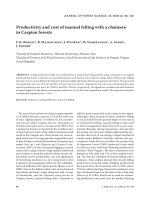
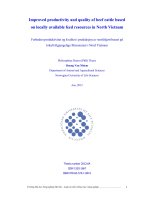
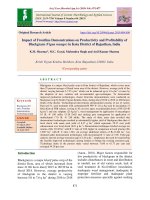

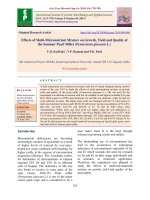
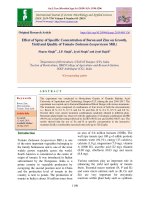
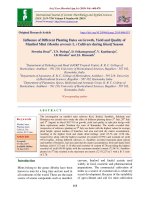
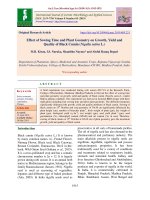
![Effect of fertility levels and stress mitigating chemicals on nutrient uptake, yield and quality of mungbean [Vigna radiata (L.) Wilczek] under loamy sand soil of Rajasthan](https://media.store123doc.com/images/document/2020_01/09/medium_ftp1578562755.jpg)
